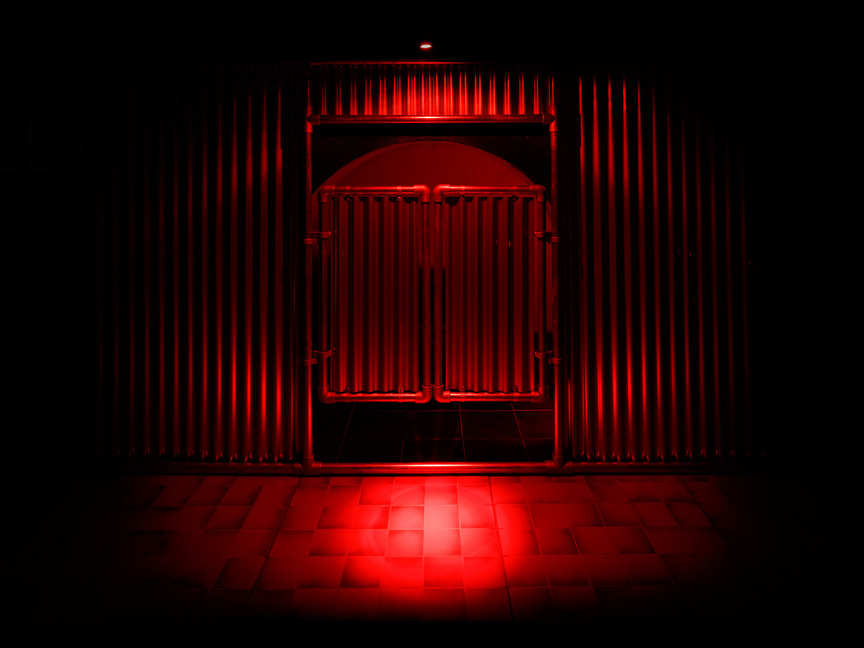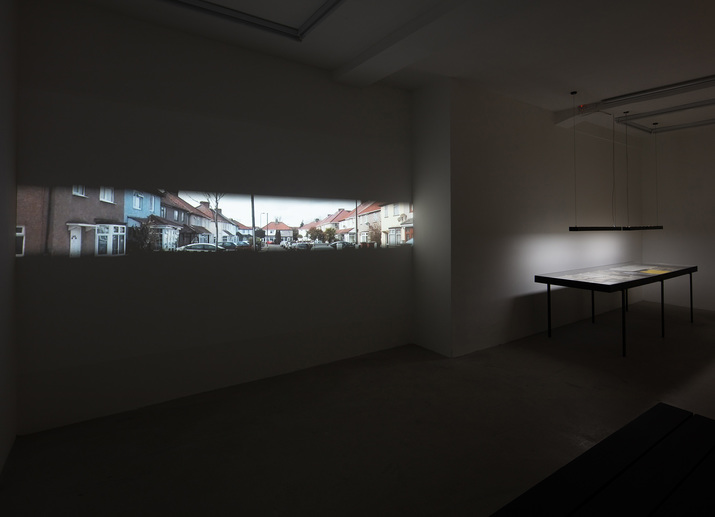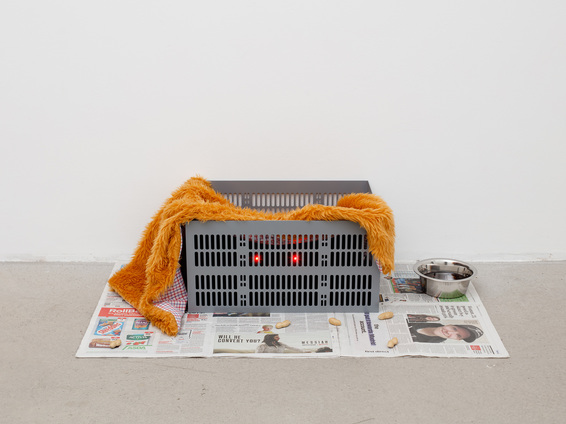
R
E
V N
E
X
T
London-born and based artist Prem Sahib’s refined and discreet aesthetic has provocative intent. With degrees in Fine Art, and Material and Visual Culture from the city’s Slade School of Fine Art and University College London, Sahib incorporates monolithic sculptures, paintings, films, and performances in his practice, unified by their crisp, clean execution and sanitized appearance, which are, by no means benign. Often re-presenting physical spaces such as nightclubs and public toilets, Sahib probes architectural values as well as the social lives and desires in the space, both prescribed and denied by it. His interventions evoke the body; yet in its absence it is very much present.
Cleo Roberts met with the artists for the opening of “Descent III. Man Dog,” the final installment of his “Descent” trilogy at London’s Southard Reid, intermixing both personal and social narratives to question conventional assumptions about sexuality and race. The three exhibitions, which began in November 2019, recreated the interior of a cruising club, captured the Southall streets of his childhood, and presented objects manifested from these spatial enquiries. Linked but not contingent upon each other, Sahib discussed his own space-making and the interconnected matrix of references across the shows.
You framed this series with “descent,” which has multiple meanings: the idea of inheritance, an overwhelming, sudden attack, and also a downward movement. Can you talk about the usage of the word and what it means for you?
I’m thinking of descent as a passage as well as lineage, and how both these experiences make us moral and social beings. For me, descent isn’t necessarily a negative decline, but a move towards something to examine it, to bring about new perspectives or change. With my first exhibition [“Descent I. People Come and Go,” 2019] I created an immersive environment based on a men-only cruise club located near the gallery. The narrow corridor of the installation led viewers down a tunnel where they may encounter a performer. I wanted to reposition the viewer in a scenario that was difficult to look at outside of the club itself; partly because it is a space reserved for a specific demographic, but also because it is personal and about where I come from. It touched on ideas around shame, death, and alienation.
Lineage was most apparent in your second exhibition, “Descent II. Cul-de-Sac,” 2019, which featured a film, Cul-de-Sac (2019), of street vistas shot at your birth place in London’s Southall, one of the city’s most racially diverse areas. Accompanying this was the presentation of an archive of newspaper cuttings. What is the relationship between the two?
When shown alongside the video, the archive became a contextual and historical device. In trying to find out more about the area I grew up in, my uncle Kamaljit Sahib offered me a folder of press clippings that he had collected before the early ’90s. Although I was familiar with some events like the 1979 Southall Riots [which began in protest of a meeting held by the far-right group, the National Front], it was interesting to learn more from his point of view through his involvement with activism and community outreach. For instance, I found letters he had written that directly challenged mainstream media narratives about Asian youths in relation to crime. There was a lot of conflated coverage about gang culture in the area, which were not viewed in relation to broader societal issues such as racism, economic hardship, and housing. Some of the language at the time was very loaded, about the cleansing of an area, with headlines like “spreading tentacles” or “operation shampoo.” I wanted the material to be accessible beyond the exhibition so I digitalized it, and viewers could download it by scanning a QR code.
Because the video incorporated my own feelings of home, estrangement, and desire, it was important for it to share the same space as the archive, so the familial, personal, and communal could co-exit. I was trying to create this analogy between different lives and experiences, as well as crossovers.
The film’s soundtrack includes different voices, and you could say that the distortion of the film, falling in and out of focus, is an expression of your own conflict with the space. Why this jarring effect?
I wanted the video to feel trippy, highlighting how a shift in perspective can transcend the familiar. I used a drone to shoot the street I grew up on, which is a cul-de-sac. The camera zooms in and out before it rises above the street, getting progressively higher. From this angle, the cul-de-sac appears almost bodily and phallic.
The soundtrack is comprised of recordings I made over the years, mostly in nightclubs where you are bombarded with sounds. There is also a recording of me sleep talking and arguing with my boyfriend. All this franticness eventually subsides with my dad playing the flute, recorded not long before he passed away, which has quite a soothing effect.
Sound was pivotal in the third exhibition, “Descent III. Man Dog.” Man Dog (2020) has an aggressive 15-minute monologue which morphs into a slow soundscape. Its source is a beautifully polished, almost mirror-like black rectangular surface on the wall. Could you explain this tirade?
The recording was from a 2017 interaction I had in an online gay chatroom on Chatroulette. At that time the site was organized based on geographical locations. The person I spoke to was in a United States chatroom and my location showed me to be in the United Kingdom. The person did not disclose his appearance on camera and while I did, I am only heard typing in the recording. The sound is played through a volcanic glass mirror—I think of it as a portrait that centres on one person’s voice. Some parts have been slowed to obscure particularly offensive language. To further regulate the amount of space given to these words, the monologue only occurs once an hour, followed by an abstracted version that suggests the resonance of such hate speech.
A number of words from this diatribe resonate with the three small metal animal cages, Ozo, Sam, and Bobby (all 2020) positioned on the floor atop sheets of newspaper, while the punctuation of the space also gives the show a morose weight. Are these sculptures embodiments of “Man Dog?”
The sentiment of “Man Dog” has to do with being confined. With the chatroom recording, the speaker made a number of references to dogs. His initial grievance was with me being in his territory. He spoke of British bulldogs and wolves in sheep’s clothing and made a sad admission about not wanting to speak to human beings at all, revealing how he spoke to a dog online. I think of the cage sculptures as still lives that embody the contrast in being comforted or alienated, of being in a domestic space or held in captivity. The baskets sit on newspapers with articles that provide a further context to some of the themes [of homophobia and racism] that reflect our current times. I was interested in the figure of a dog for a number of reasons, mostly to do with ideas of companionship, loneliness, submission, and power, but also how in numerous world mythologies the dog is seen as our constant companion, much like our other constant companion, death.
You have, throughout the three exhibitions, drawn focus onto the floor. In “People Come and Go” there was detritus left scattered across the ground, and in “Man Dog” there were the cages, as well as the sculpture Beneficiary (2020)—an arrangement of four pairs of legs behind a wall, all sporting bright white trainers and socks. Why this perspective?
In “People Come and Go,” the remnants on the floor have to do with losing yourself and your belongings, shedding the things that tie you to the material world and getting out of yourself. They also made the installation feel like a habitat you were intruding on when the performer wasn’t there. This relates to the bedding and cage-like structures in Ozo, Sam, and Bobby. These baskets are similar to the ones found at the cruising club for people to leave their possessions in. I often saw these in proximity to men’s shirting, leading me to think of the checked, grid, and stripe patterns as the cages themselves. I used similar types of cloths in combination with fake fur, to make something that was both animalistic and human, and related to comfort and adolescence.
Your work is regarded as architectural by many—do you think of the space you explore like the cruising clubs in terms of the male body or the body in general?
I’m interested in how we are shaped by the ideological underpinning of a space. Many of the spaces I have made works about center on and privilege male bodies, but I wouldn’t say my concern is limited to this. Because of my own gender and racial identity, recently I have found myself looking more at the bodies that are given agency. I think this is about questioning how power can function through ubiquity, but also not feeling confined to making works solely about my identity as a person of color. Works such as Beneficiary are an example of this—it is comprised of eight identical legs with feet in uniform white trainers that are partially visible, pointing to a tribal alliance as well as a homogenous social body, one which like that of a spider, is the beneficiary of its web.
Prem Sahib’s “Descent III. Man Dog” is on view at Southard Reid, London, until March 7, 2020.
To read more of ArtAsiaPacific’s articles, visit our Digital Library.





















